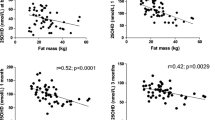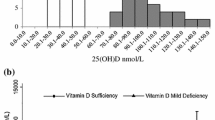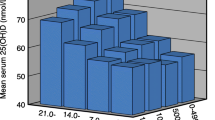Abstract
Summary
The goal in this study was to examine the hormonal and dietary predictors of true fractional Ca absorption (TFCA) in adult women and to determine whether TFCA differs due to body weight. Results showed that TFCA is higher in obese individuals and dietary fat, estradiol, and 1,25-dihydroxy vitamin D are the most significant positive predictors of TFCA in adult women.
Introduction
Calcium absorption is an important determinant of calcium balance and is influenced by several factors. Previous studies have identified that age, intake of protein, fat and fiber, and hormones such as 1, 25-dihyroxyvitamin D (1,25(OH)2D3) influence absorption. The determinants of TFCA using the double isotope method, the gold standard estimate of absorption, have not been examined previously in adult women nor has the role of obesity been addressed.
Methods
In this study, we examined the hormonal and dietary predictors of TFCA in adult women with a wide range of age, body weights, and nutrient intake. TFCA was measured using dual stable isotope (42Ca and 43Ca) technique. Serum was analyzed for bone-regulating hormones, and dietary information was obtained through food records. The independent dietary factors and hormonal predictors (25-hydroxyvitamin D, 1,25(OH)2D3, parathyroid hormone, and estradiol) of TFCA were analyzed using multiple regression analysis.
Results
Two hundred twenty-nine women aged 54 ± 11 years old (24–75 years) and with BMI of 31 ± 7.0 kg/m2 were eligible and were categorized into tertiles of body mass index (BMI) into leaner, overweight, and obese. In the entire group of women, total fat intake, estradiol, and 1,25(OH)2D3 are significant positive predictors (p < 0.05). As expected, age is a significant negative predictor of TFCA (R 2 = 26%). TFCA is higher in obese women compared to non-obese women (p < 0.05).
Conclusion
Together, these data show that dietary fat is the most significant positive predictor of TFCA which may have implications for dietary intake for non-obese individuals who are more likely to have lower and potentially compromised Ca absorption.

Similar content being viewed by others
References
Ensrud KE, Duong T, Cauley JA, Heaney RP, Wolf RL, Harris E, Cummings SR (2000) Low fractional calcium absorption increases the risk for hip fracture in women with low calcium intake. Study of Osteoporotic Fractures Research Group. Ann Intern Med 132:345–53
Need AG, Morris HA, Horowitz M, Scopacasa E, Nordin BE (1998) Intestinal calcium absorption in men with spinal osteoporosis. Clin Endocrinol (Oxf) 48:163–68
Nordin BE, Need AG, Morris HA, O'Loughlin PD, Horowitz M (2004) Effect of age on calcium absorption in postmenopausal women. Am J Clin Nutr 80:998–1002
Nordin BE, Robertson A, Seamark RF, Bridges A, Philcox JC, Need AG, Horowitz M, Morris HA, Deam S (1985) The relation between calcium absorption, serum dehydroepiandrosterone, and vertebral mineral density in postmenopausal women. J Clin Endocrinol Metab 60:651–57
Smith E, Need AG, Schultz CG, Horowitz M (2004) Does the response of bone mass to calcium supplements depend on calcium absorption efficiency? Eur J Endocrinol 151:759–63
Wolf RL, Cauley JA, Baker CE, Ferrell RE, Charron M, Caggiula AW, Salamone LM, Heaney RP, Kuller LH (2000) Factors associated with calcium absorption efficiency in pre- and perimenopausal women. Am J Clin Nutr 72:466–71
Heaney RP, Recker RR (1985) Estimation of true calcium absorption. Ann Intern Med 103:516–21
Wishart JM, Scopacasa F, Horowitz M, Morris HA, Need AG, Clifton PM, Nordin BE (2000) Effect of perimenopause on calcium absorption: a longitudinal study. Climacteric 3:102–8
Van Cromphaut SJ, Rummens K, Stockmans I, Van HE, Dijcks FA, Ederveen AG, Carmeliet P, Verhaeghe J, Bouillon R, Carmeliet G (2003) Intestinal calcium transporter genes are upregulated by estrogens and the reproductive cycle through vitamin D receptor-independent mechanisms. J Bone Miner Res 18:1725–36
Need AG, O'Loughlin PD, Morris HA, Horowitz M, Nordin BE (2004) The effects of age and other variables on serum parathyroid hormone in postmenopausal women attending an osteoporosis center. J Clin Endocrinol Metab 89:1646–49
Bronner F (2009) Recent developments in intestinal calcium absorption. Nutr Rev 67:109–13
Ajibade DV, Dhawan P, Fechner AJ, Meyer MB, Pike JW, Christakos S (2010) Evidence for a role of prolactin in calcium homeostasis: regulation of intestinal transient receptor potential vanilloid type 6, intestinal calcium absorption, and the 25-hydroxyvitamin D(3) 1alpha hydroxylase gene by prolactin. Endocrinology 151:2974–84
Heaney RP (2011) 25-Hydroxyvitamin D and calcium absorption. Am J Clin Nutr 93:220–221
Aloia JF, Chen DG, Yeh JK, Chen H (2010) Serum vitamin D metabolites and intestinal calcium absorption efficiency in women. Am J Clin Nutr 92:835–40
Sai AJ, Walters RW, Fang X, Gallagher JC (2011) Relationship between Vitamin D, parathyroid hormone, and bone health. J Clin Endocrinol Metab 96:E436–E446
Need AG, O'Loughlin PD, Morris HA, Coates PS, Horowitz M, Nordin BE (2008) Vitamin D metabolites and calcium absorption in severe vitamin D deficiency. J Bone Miner Res 23:1859–63
Gaffney-Stomberg E, Insogna KL, Rodriguez NR, Kerstetter JE (2009) Increasing dietary protein requirements in elderly people for optimal muscle and bone health. J Am Geriatr Soc 57:1073–79
Kerstetter JE, O'Brien KO, Caseria DM, Wall DE, Insogna KL (2005) The impact of dietary protein on calcium absorption and kinetic measures of bone turnover in women. J Clin Endocrinol Metab 90:26–31
Hansen KE, Jones AN, Lindstrom MJ, Davis LA, Engelke JA, Shafer MM (2008) Vitamin D insufficiency: disease or no disease? J Bone Miner Res 23:1052–60
Park CY, Hill KM, Elble AE, Martin BR, DiMeglio LA, Peacock M, McCabe GP, Weaver CM (2010) Daily supplementation with 25 mug cholecalciferol does not increase calcium absorption or skeletal retention in adolescent girls with low serum 25-hydroxyvitamin D. J Nutr 140:2139–44
Zhu K, Bruce D, Austin N, Devine A, Ebeling PR, Prince RL (2008) Randomized controlled trial of the effects of calcium with or without vitamin D on bone structure and bone-related chemistry in elderly women with vitamin D insufficiency. J Bone Miner Res 23:1343–48
Bell NH, Epstein S, Greene A, Shary J, Oexmann MJ, Shaw S (1985) Evidence for alteration of the vitamin D-endocrine system in obese subjects. J Clin Invest 76:370–373
Parikh SJ, Edelman M, Uwaifo GI, Freedman RJ, Semega-Janneh M, Reynolds J, Yanovski JA (2004) The relationship between obesity and serum 1,25-dihydroxy vitamin D concentrations in healthy adults. J Clin Endocrinol Metab 89:1196–99
Wortsman J, Matsuoka LY, Chen TC, Lu Z, Holick MF (2000) Decreased bioavailability of vitamin D in obesity. Am J Clin Nutr 72:690–693
Bolland MJ, Grey AB, Ames RW, Horne AM, Gamble GD, Reid IR (2006) Fat mass is an important predictor of parathyroid hormone levels in postmenopausal women. Bone 38:317–21
Pitroda AP, Harris SS, Dawson-Hughes B (2009) The association of adiposity with parathyroid hormone in healthy older adults. Endocrine 36:218–23
Sukumar D, Schlussel Y, Riedt CS, Gordon C, Stahl T, Shapses SA (2011) Obesity alters cortical and trabecular bone density and geometry in women. Osteoporos Int 22:635–45
Pinkney JH, Kopelman PG (2011) Endocrine determinants of obesity. Handbook of Obesity- Etiology and Pathophysiology 655-69
Mahabir S, Baer DJ, Johnson LL, Hartman TJ, Dorgan JF, Campbell WS, Clevidence BA, Taylor PR (2006) Usefulness of body mass index as a sufficient adiposity measurement for sex hormone concentration associations in postmenopausal women. Cancer Epidemiol Biomarkers Prev 15:2502–7
Cifuentes M, Advis JP, Shapses SA (2004) Estrogen prevents the reduction in fractional calcium absorption due to energy restriction in mature rats. J Nutr 134:1929–34
Cifuentes M, Riedt CS, Brolin RE, Field MP, Sherrell RM, Shapses SA (2004) Weight loss and calcium intake influence calcium absorption in overweight postmenopausal women. Am J Clin Nutr 80:123–30
Arunabh S, Pollack S, Yeh J, Aloia JF (2003) Body fat content and 25-hydroxyvitamin D levels in healthy women. J Clin Endocrinol Metab 88:157–61
Barger-Lux MJ, Heaney RP (2005) Calcium absorptive efficiency is positively related to body size. J Clin Endocrinol Metab 90:5118–20
Christakos S, Dhawan P, Porta A, Mady LJ, Seth T (2011) Vitamin D and intestinal calcium absorption. Mol Cell Endocrinol 347(1–2):25–9
Wood RJ, Fleet JC, Cashman K, Bruns ME, Deluca HF (1998) Intestinal calcium absorption in the aged rat: evidence of intestinal resistance to 1,25(OH)2 vitamin D. Endocrinology 139:3843–48
Institute of Medicine (2011) Dietary Reference Intakes for Calcium and Vitamin D. The National Academies Press, Washington, DC
Armbrecht HJ, Forte LR, Halloran BP (1984) Effect of age and dietary calcium on renal 25(OH)D metabolism, serum 1,25(OH)2D, and PTH. Am J Physiol 246:E266–E270
Heaney RP, Recker RR, Stegman MR, Moy AJ (1989) Calcium absorption in women: relationships to calcium intake, estrogen status, and age. J Bone Miner Res 4:469–75
Ten BM, Netelenbos JC, Barto R, Van Buuren LM, van der Vijgh WJ (1999) Estrogen regulation of intestinal calcium absorption in the intact and ovariectomized adult rat. J Bone Miner Res 14:1197–202
O'Loughlin PD, Morris HA (1998) Oestrogen deficiency impairs intestinal calcium absorption in the rat. J Physiol 511(Pt 1):313–22
Heaney RP (2005) The Vitamin D requirement in health and disease. J Steroid Biochem Mol Biol 97:13–19
Thacher TD, Obadofin MO, O'Brien KO, Abrams SA (2009) The effect of vitamin D2 and vitamin D3 on intestinal calcium absorption in Nigerian children with rickets. J Clin Endocrinol Metab 94:3314–21
Abrams SA, Hicks PD, Hawthorne KM (2009) Higher serum 25-hydroxyvitamin D levels in school-age children are inconsistently associated with increased calcium absorption. J Clin Endocrinol Metab 94:2421–27
Shapses SA, Kendler D, Robson R, Hansen KE, Sherrel R, Field MP, Woolf E, Berd Y, Mantz AM, Santora A (2011) Effect of alendronate and vitamin D(3) on fractional calcium absorption in a double-blind, randomized, placebo-controlled trial in postmenopausal osteoporotic women. J Bone Miner Res 26(8):1836–44
Nagata C, Nagao Y, Shibuya C, Kashiki Y, Shimizu H (2005) Fat intake is associated with serum estrogen and androgen concentrations in postmenopausal Japanese women. J Nutr 135:2862–65
Wu AH, Pike MC, Stram DO (1999) Meta-analysis: dietary fat intake, serum estrogen levels, and the risk of breast cancer. J Natl Cancer Inst 91:529–34
Fontaine O, Matsumoto T, Goodman DB, Rasmussen H (1981) Liponomic control of Ca2+ transport: relationship to mechanism of action of 1,25-dihydroxyvitamin D3. Proc Natl Acad Sci U S A 78:1751–54
Cartwright IJ, Higgins JA (1999) Increased dietary triacylglycerol markedly enhances the ability of isolated rabbit enterocytes to secrete chylomicrons: an effect related to dietary fatty acid composition. J Lipid Res 40:1858–66
Niramitmahapanya S, Harris SS, Dawson-Hughes B (2011) Type of dietary fat is associated with the 25-hydroxyvitamin D3 increment in response to vitamin D supplementation. J Clin Endocrinol Metab 96(10):3170–4
Xiao Y, Cui J, Li YX, Shi YH, Wang B, Le GW, Wang ZP (2010) Dyslipidemic high-fat diet affects adversely bone metabolism in mice associated with impaired antioxidant capacity. Nutrition 27(2):214–20
Armstrong ME, Spencer EA, Cairns BJ, Banks E, Pirie K, Green J, Wright FL, Reeves GK, Beral V (2011) Body mass index and physical activity in relation to the incidence of hip fracture in postmenopausal women. J Bone Miner Res 26:1330–1338
Heaney RP, Weaver CM (2005) Newer perspectives on calcium nutrition and bone quality. J Am Coll Nutr 24:574S–81S
Shapses SA, Riedt CS (2006) Bone, body weight, and weight reduction: what are the concerns? J Nutr 136:1453–56
Acknowledgments
We wish to thank Drs. Riedt, Cifuentes and Sherrell, and Hasina Ambia-Sobhan for their effort in the clinical trials and/or laboratory analysis. We also thank the volunteers for their commitment in these studies. Funding sources for this study are NIH-NIA-AG12161, NH-ODS, NJAES-0153866, and a Busch Biomedical (201095157).
Conflicts of interest
None
Author information
Authors and Affiliations
Corresponding author
Rights and permissions
About this article
Cite this article
Shapses, S.A., Sukumar, D., Schneider, S.H. et al. Hormonal and dietary influences on true fractional calcium absorption in women: role of obesity. Osteoporos Int 23, 2607–2614 (2012). https://doi.org/10.1007/s00198-012-1901-5
Received:
Accepted:
Published:
Issue Date:
DOI: https://doi.org/10.1007/s00198-012-1901-5




